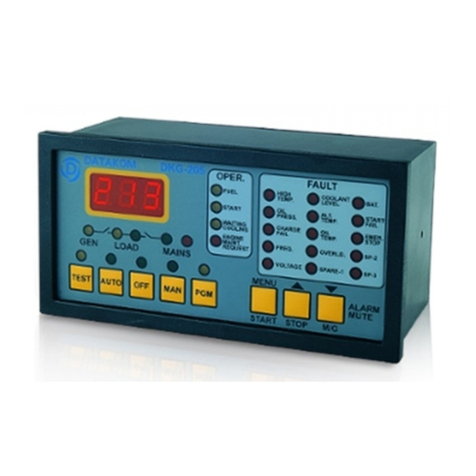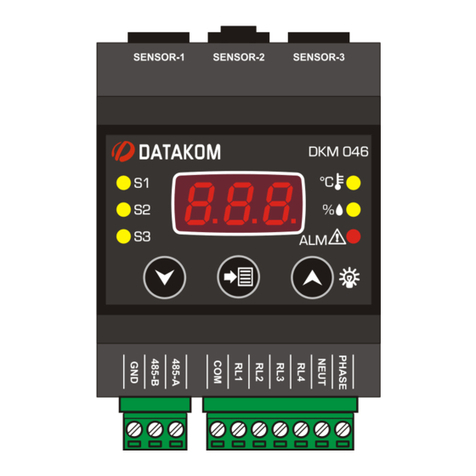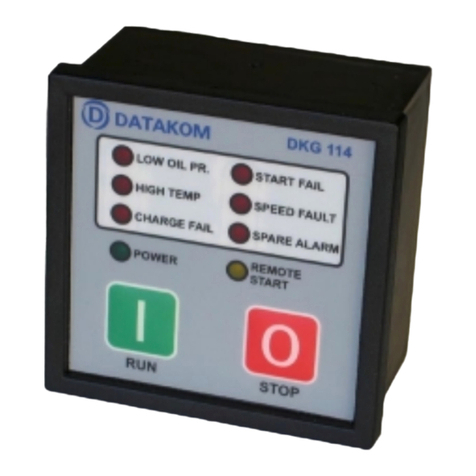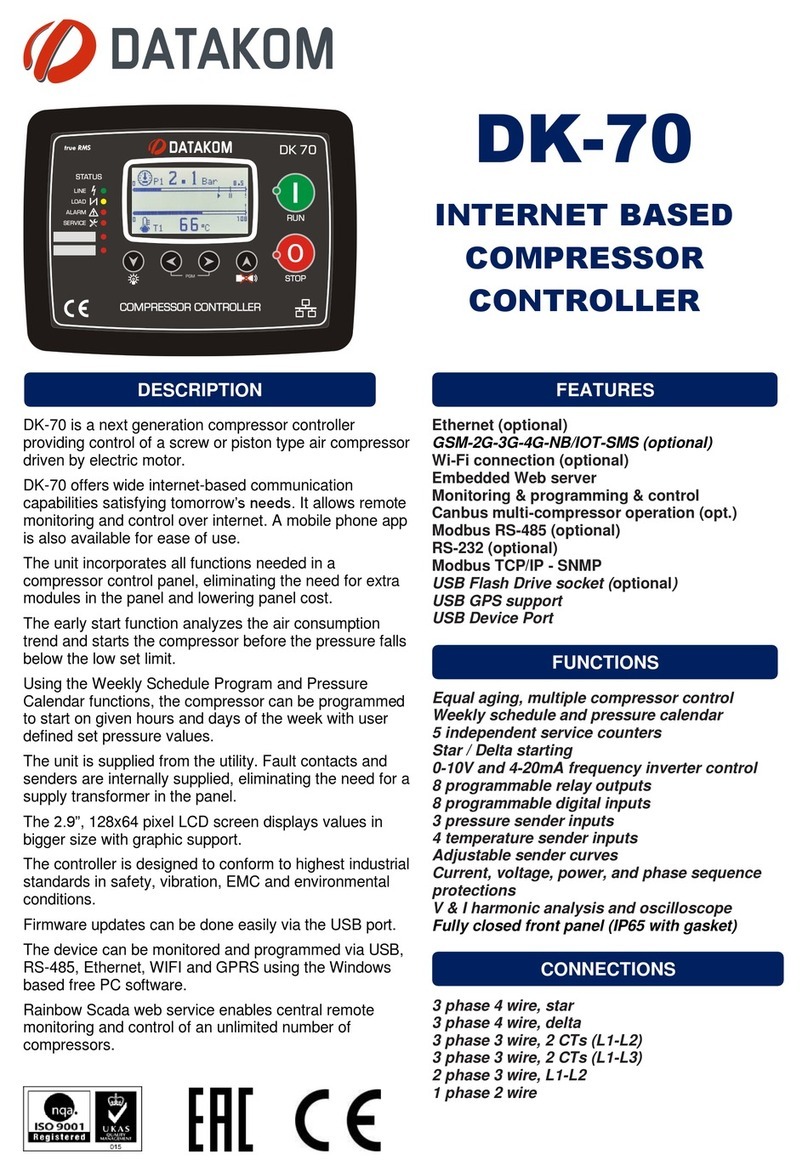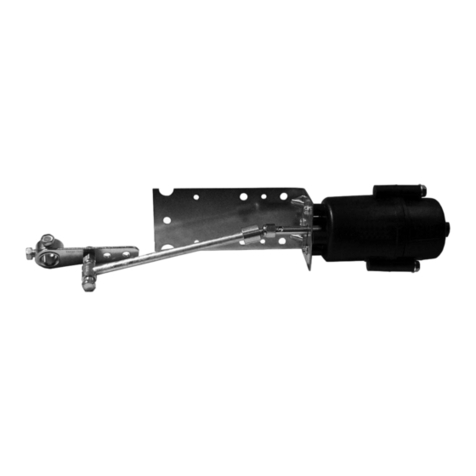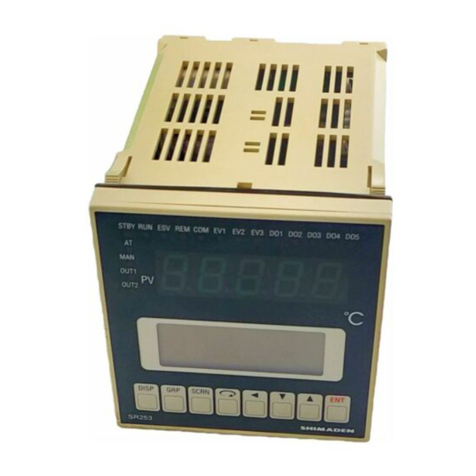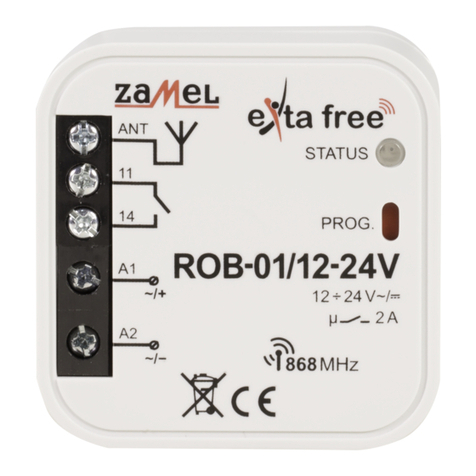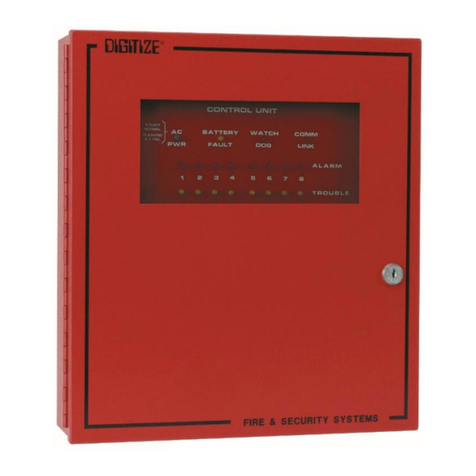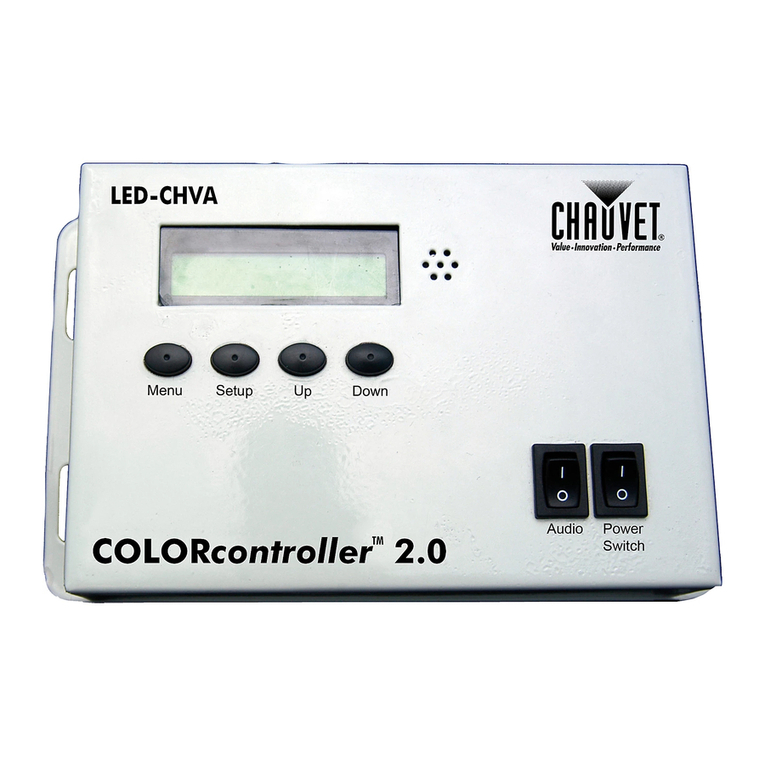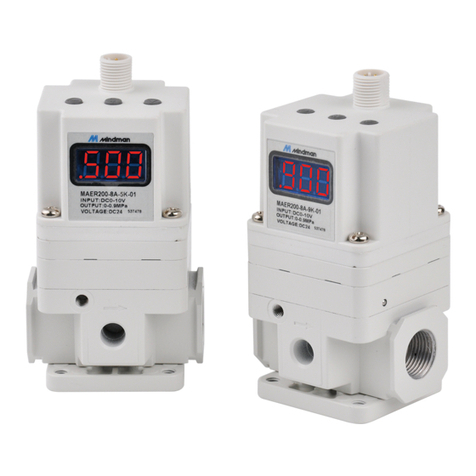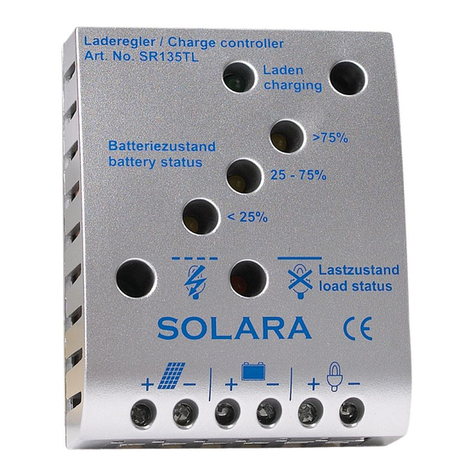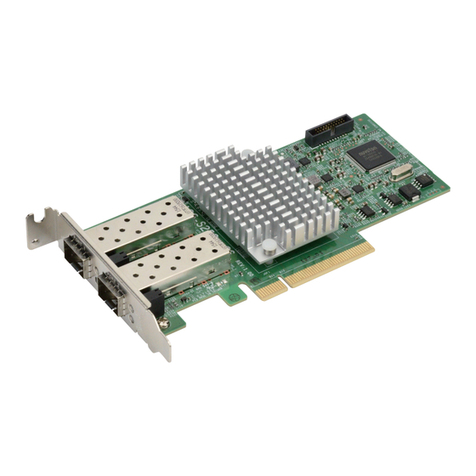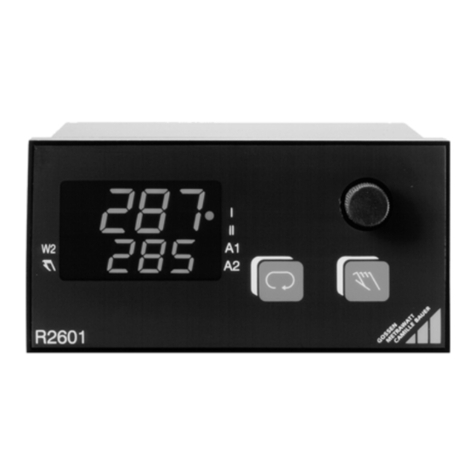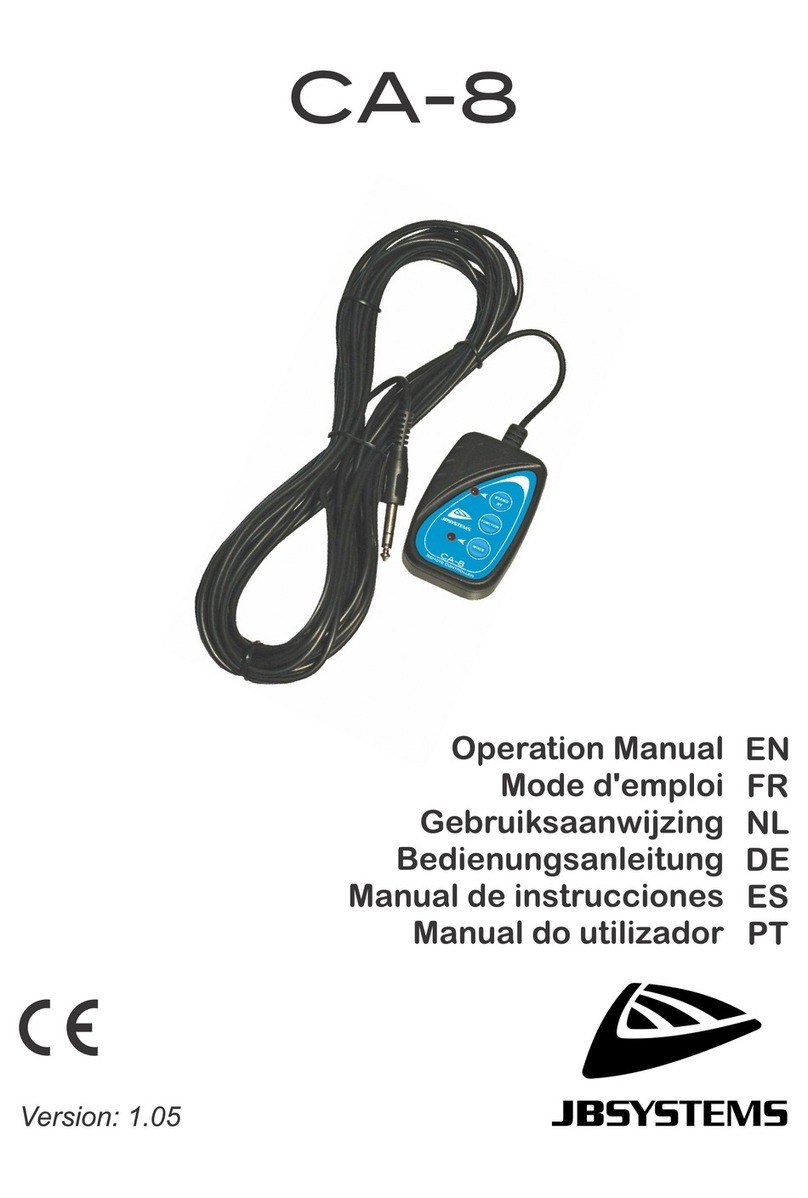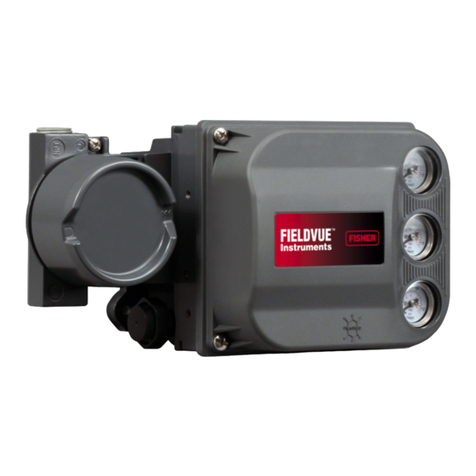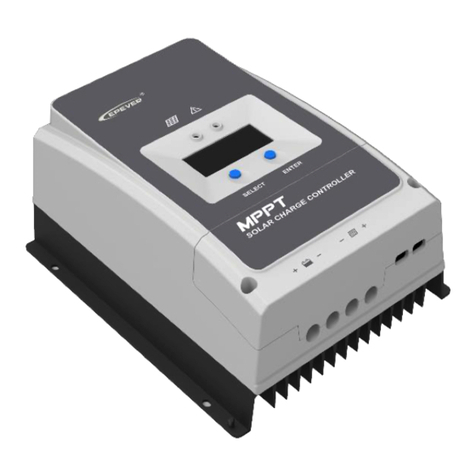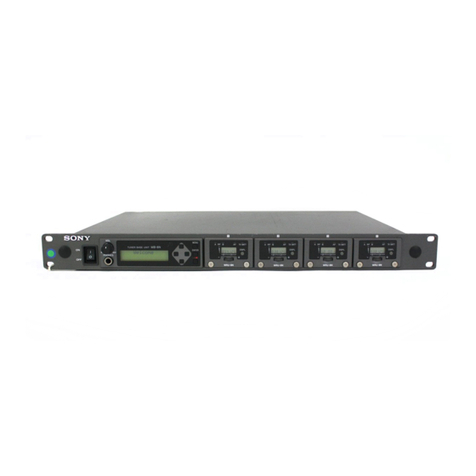Datakom DKG-379 User manual

DKG-379 User Manual Rev_02 V-15 (24-12-2012)
DKG-379
VARIABLE SPEED DC
GENSET CONTROLLER
CANBUS AND MPU VERSIONS
The DKG-379 is an advanced DC genset controller for both
variable and fixed speed systems. It is presented in 3 different
versions, as ANALOG DRIVE, POWER DRIVE and CANBUS
DRIVE.
The controller has a precision PID loop providing exact
matching of the optimal charging characteristics, as well as
overvoltage, overcurrent, overspeed, overheat protections.
The POWER DRIVE version provides a 7 Amp-DC output,
interfacing directly to the engine actuator or alternator
excitation winding without the need for a governor controller or
AVR. The CANBUS DRIVE version connects to ECU driven
electronic engines providing engine control, protection and
instrumentation without extra senders. ECU alarms are
displayed in text. All versions offer a 0-10V analog output for
speed or voltage control.
The fixed speed operation stops the genset precisely when
batteries are fully charged, providing fuel economy and
maintenance cost reductions.
The unit has precision, fully isolated measuring inputs for the
battery bank voltage and the charge current. It supports both
“positive to ground” and “negative to ground” installations.
The current is measured through a DC current shunt placed in
positive or negative output of the genset.
The genset starting is based on the precisely measured DC
battery bank voltage. Once started, the controller will perform
an optimal battery charging cycle and will stop the genset
when batteries are fully charged. The optimal charge algorithm
allows maximum battery life and minimal engine run time and
fuel consumption.
During the charge cycle, the unit controls the engine rpm (or
excitation) in order to apply the exact required DC voltage and
current to batteries. The rpm control over CANBUS-J1939 is
available for electronic engines.
The unit offers a PT100 type, battery temperature sensor
input. If used, the temperature protection will allow longer
battery life in hot environment and faster charge in cold
conditions.
Compatible with 12V, 24V and 48V DC systems
DC power drive output (7A-DC)
ECU connection through J1939 CAN option
0-10V analog control output
Isolated Volt - Amp measurements
Battery temperature input for PT100 sensor
Optimal charging, provides longer battery life
Temperature dependent battery charging
Thermal protection, short circuit protection
Dual genset mutual standby operation
100 event logs with time stamp and
measurements
Battery backed-up real time clock
Built in daily / weekly / monthly exerciser
Field adjustable parameters
RS-232 serial port
Free MS-Windows Remote monitoring SW
GSM and PSTN modem support
GSM SMS message sending on fault
MODBUS communications
Multiple language support
Customer logo display capability
Battery Volts
Battery temperature
Generator Volts
Generator Amps
Generator kW
Engine rpm
Engine battery Voltage
Engine Coolant Temperature
Engine Oil Pressure
Engine fuel Level
Engine Oil Temperature
MEASUREMENTS
FEATURES
DESCRIPTION

DKG-379 User Manual Rev_02 V-15 (24-12-2012)
K43D01-EN - 2 -
Any unauthorized use or copying of the contents or any part of this document is prohibited.
This applies in particular to trademarks, model denominations, part numbers and drawings.
This document describes minimum requirements and necessary steps for the successful installation of the
DKG-379 unit.
Follow carefully advices given in the document. These are often good practices for the installation of genset
control units which reduce future issues.
For all technical queries please contact Datakom at below e-mail address:
FILENAME
DESCRIPTION
379_INSTE
DKG-379 Installation Guide
REVISION
DATE
AUTHOR
DESCRIPTION
01
04.04.2012
MH
First issue, firmware version 12, hardware version 02
02
24.12.2012
MH
Updated for firmware version 15, hardware version 03
CAUTION: Potential risk of injury or death.
WARNING: Potential risk of malfunction or material damage.
ATTENTION: Useful hints for the understanding of device operation.
TERMINOLOGY
REVISION HISTORY
RELATED DOCUMENTS
ABOUT THIS DOCUMENT
COPYRIGHT NOTICE

DKG-379 User Manual Rev_02 V-15 (24-12-2012)
K43D01-EN - 3 -
The D-500 family units are available in various options and peripheral features. Please use below
information for ordering the correct version:
DKG-379
-MPU
-G
-T
-00
Screw type bracket
Stock Code=J10P01 (per unit)
Self Retaining type bracket
Stock Code=K16P01 (per unit)
Sealing Gasket, Stock Code= K44P01
SPARE PARTS
ORDERING CODES
Family Code
MPU: Magnetic pickup input
CAN: Canbus J1939 port
With Sealing
gasket
With Conformal
Coating
Variant
00: standard unit
01...99: customer
specific products

DKG-379 User Manual Rev_02 V-15 (24-12-2012)
K43D01-EN - 4 -
▪Electrical equipment should be installed only by qualified specialist.
No responsibility is assured by the manufacturer or any of its
subsidiaries for any consequences resulting from the non-
compliance to these instructions.
▪Check the unit for cracks and damages due to transportation. Do not
install damaged equipment.
▪Do not open the unit. There are no serviceable parts inside.
▪Fuses must be connected to the power supply and phase voltage
inputs, in close proximity of the unit.
▪Fuses must be of fast type (FF) with a maximum rating of 6A.
▪Disconnect all power before working on equipment.
▪Any electrical parameter applied to the device must be in the range
specified in the user manual. Although the unit is designed with a
wide safety margin, over-range parameters may reduce lifetime, alter
operational precision or even damage the unit.
▪Do not try to clean the device with solvent or the like. Only clean
with a dump cloth.
▪Verify correct terminal connections before applying power.
▪Only for front panel mounting.
SAFETY NOTICE
Failure to follow below instructions
will result in death or serious injury
Resistive Current Shunt must be used for current
measurement.
No direct connection allowed.

DKG-379 User Manual Rev_02 V-15 (24-12-2012)
K43D01-EN - 5 -
1.INSTALLATION INSTRUCTIONS
2.MOUNTING
2.1. DIMENSIONS
2.2. SEALING, GASKET
2.3. ELECTRICAL INSTALLATION
3. TERMINAL DESCRIPTIONS
3.1. BATTERY VOLTAGE INPUT
3.2. BATTERY BANK DC VOLTAGE INPUTS
3.3. BATTERY BANK CHARGE CURRENT INPUT
3.4. DIGITAL INPUTS
3.5. ANALOG SENDER INPUTS AND SENDER GROUND
3.6. CHARGE INPUT TERMINAL
3.7. DIGITAL OUTPUTS
3.8. LOAD CONTACTOR OUTPUT
3.9. ANALOG OUTPUT
3.10. MAGNETIC PICKUP INPUT
3.11. INPUT/OUTPUT EXTENSION
3.12. J1939-CANBUS PORT
3.13. RS-232 PORT (OPTIONAL)
4. CONNECTION DIAGRAM
5. TERMINAL DESCRIPTION
6. TECHNICAL SPECIFICATIONS
7. DESCRIPTION OF CONTROLS
7.1. FRONT PANEL FUNCTIONALITY
7.2. PUSHBUTTON FUNCTIONS
7.3. DISPLAY SCREEN ORGANIZATION
7.4. LED LAMPS
8. DISPLAYING EVENT LOGS
9. STATISTICAL COUNTERS
10. OPERATION OF THE UNIT
10.1. QUICK START GUIDE
10.2.STOP MODE
10.3. AUTO MODE
10.4. RUN MODE, MANUAL CONTROL
10.5. TEST MODE
11. OPTIMAL CHARGING, VARIABLE SPEED OPERATION
11.1. RELATED PARAMETERS
11.2. OPTIMAL CHARGE CYCLE DESCRIPTION
11.3. EFFECT OF BATTERY BANK TEMPERATURE
11.4. RPM CONTROL
12. UNCONTROLLED CHARGING, FIXED SPEED OPERATION
12.1. RELATED PARAMETERS
12.2. UNCONTROLLED CHARGE CYCLE DESCRIPTION
TABLE OF CONTENTS

DKG-379 User Manual Rev_02 V-15 (24-12-2012)
K43D01-EN - 6 -
13. PROTECTIONS AND ALARMS
13.1. SHUTDOWN ALARMS
13.2. LOADDUMP ALARMS
13.3. WARNINGS
14. PROGRAMMING
14.1. RESETTING TO FACTORY DEFAULTS
14.2. ENTERING THE PROGRAMMING MODE
14.3. NAVIGATING BETWEEN MENUS
14.4. MODIFYING PARAMETER VALUE
14.5. PROGRAMMING MODE EXIT
15. PROGRAM PARAMETER LIST
15.1. CONTROLLER CONFIGURATION GROUP
15.2. ELECTRICAL PARAMETERS GROUP
15.3. ENGINE PARAMETERS GROUP
15.4. ADJUST DATE AND TIME
15.5. WEEKLY OPERATION SCHEDULE
15.6. SENDER CHARACTERISTICS
15.7. INPUT CONFIGURATION
15.8. RELAY DEFINITIONS
15.9. INPUT FUNCTION SELECT
15.10. SITE ID STRING
15.11. MODEM1-2/SMS1-2-3-4 TELEPHONE NUMBERS
16. CRANK CUTTING
17. J1939 CANBUS ENGINE SUPPORT
18. SOFTWARE FEATURES
18.1. Charging the Engine Battery
18.2. Speed UP/DOWN Relay Outputs
18.3. Remote Start Operation
18.4. Disable Auto Start
18.5. Dual Genset Mutual Standby Operation
18.6. External Control of the Unit
18.7. Automatic Exerciser
18.8. Weekly Operation Scheduler
18.9. Engine Heating Operation
18.10. Engine Idle Speed Operation
18.11. Engine Block Heater
18.12. Fuel Pump Control
18.13. Gas Engine Fuel Solenoid Control
19. MODBUS SUPPORT
19.1. Modbus Register Map
20. DECLARATION OF CONFORMITY
21. MAINTENANCE
22. DISPOSAL OF THE UNIT
23. ROHS COMPLIANCE
24. TROUBLESHOOTING GUIDE
TABLE OF CONTENTS (continued)

DKG-379 User Manual Rev_02 V-15 (24-12-2012)
K43D01-EN - 7 -
Before installation:
•Read the user manual carefully, determine the correct connection diagram.
•Remove all connectors and mounting brackets from the unit, then pass the unit through the mounting
opening.
•Put mounting brackets and tighten. Do not tighten too much, this can brake the enclosure.
•Make electrical connections with plugs removed from sockets, then place plugs to their sockets.
•Be sure that adequate cooling is provided.
•Be sure that the temperature of the environment will not exceed the maximum operating temperature
in any case.
Below conditions may damage the device:
•Incorrect connections.
•Incorrect power supply voltage.
•Voltage at measuring terminals beyond specified range.
•Voltage applied to digital inputs over specified range.
•Overload or short circuit at relay outputs
•Connecting or removing data terminals when the unit is powered-up.
•High voltage applied to communication ports.
•Ground potential differences at non-isolated communication ports.
•Excessive vibration, direct installation on vibrating parts.
Below conditions may cause abnormal operation:
•Power supply voltage below minimum acceptable level.
•Current shunt polarity incorrect.
•Missing grounding.
Resistive Current Shunt must be used for current
measurement.
No direct connection allowed.
1. INSTALLATION INSTRUCTIONS

DKG-379 User Manual Rev_02 V-15 (24-12-2012)
K43D01-EN - 8 -
Dimensions: 172x134x76mm (6.8”x5.3”x3.0”)
Panel Cutout: 151x111mm minimum (6.0”x4.4”)
Weight: 450g (1 lb)
2.1. DIMENSIONS
2. MOUNTING

DKG-379 User Manual Rev_02 V-15 (24-12-2012)
K43D01-EN - 9 -
The unit is designed for panel mounting. The user should not be able to access parts of the unit other than
the front panel.
Mount the unit on a flat, vertical surface. Before mounting, remove the mounting brackets and connectors from
the unit, then pass the unit through the mounting opening.
Place and tighten mounting brackets.
Panel Cutout
Required Panel Depth

DKG-379 User Manual Rev_02 V-15 (24-12-2012)
K43D01-EN - 10 -
Two different types of brackets are provided:
Screw type bracket
Self retaining type bracket
Installation of screw type bracket
Installation of self retaining type bracket
Do not tighten too much, this may break the unit.

DKG-379 User Manual Rev_02 V-15 (24-12-2012)
K43D01-EN - 11 -
The rubber gasket provides a watertight means of mounting the module to the genset panel. Together with
the gasket, IEC 60529-IP65 protection can be reached from the front panel. A short definition of IP protection
levels is given below.
1st Digit Description of Protection Level
0 Not protected
1 Protected against solid foreign objects of 50 mm diameter and greater
2 Protected against solid foreign objects of 12,5 mm diameter and greater
3 Protected against solid foreign objects of 2,5 mm diameter and greater
4 Protected against solid foreign objects of 1,0 mm diameter and greater
5 Protected from the amount of dust that would interfere with normal operation
6 Dust tight
2nd Digit Description of Protection Level
0 Not protected
1 Protected against vertically falling water drops
2 Protected against vertically falling water drops when enclosure is tilted up to 15 °
3 Protected against water sprayed at an angle up to 60 ° on either side of the vertical
4 Protected against water splashed against the component from any direction
5 Protected against water projected in jets from any direction
6 Protected against water projected in powerful jets from any direction
7 Protected against temporary immersion in water
8 Protected against continuous immersion in water, or as specified by the user
2.2. SEALING, GASKET
Gasket
Panel
Module

DKG-379 User Manual Rev_02 V-15 (24-12-2012)
K43D01-EN - 12 -
Although the unit is protected against electromagnetic disturbance, excessive disturbance
can affect the operation, measurement precision and data communication quality.
•ALWAYS remove plug connectors when inserting wires with a screwdriver.
•Fuses must be connected to the power supply voltage inputs, in close
proximity of the unit.
•Fuses must be of fast type (FF) with a maximum rating of 6A.
•Use cables of appropriate temperature range.
•Use adequate cable section, at least 0.75mm2 (AWG18).
•Follow national rules for electrical installation.
•Current shunts must have 60mV output at nominal current.
For the correct operation of the exerciser and
weekly schedule programs, adjust the real time
clock of the unit through programming menu.
The engine body must be grounded. Otherwise faulty
voltage and frequency measurements may occur.
Resistive Current Shunts must be used for current
measurement.
No direct connection allowed.
Do not install the unit close to high electromagnetic
noise emitting devices like contactors, high current
busbars, switchmode power supplies and the like.
2.3. ELECTRICAL INSTALLATION

DKG-379 User Manual Rev_02 V-15 (24-12-2012)
K43D01-EN - 13 -
Supply voltage:
9 to 33VDC
Cranking dropouts:
Survives 0VDC during 100ms. The voltage before surge should be
9VDC minimum
Overvoltage protection:
Withstands 150VDC continuously.
Reverse voltage:
-33VDC continuous
Maximum operating
current:
250mA @ 12/24VDC. (All options included, digital outputs open.)
Typical operating current:
200mA @ 12/24VDC. (all options passive, digital outputs open)
Measurement range:
0 to 36VDC
Display resolution:
0.1VDC
Accuracy:
0.5% + 1 digit @ 24VDC
3.1. BATTERY VOLTAGE INPUT
3. TERMINAL DESCRIPTIONS

DKG-379 User Manual Rev_02 V-15 (24-12-2012)
K43D01-EN - 14 -
Measurement method:
Isolated DC voltage measurement
Sampling rate:
100K s/s
Input voltage range:
0 to 70 VDC
Measurement range:
0 to 70VDC
Input impedance:
215 K-ohms
Display resolution:
0.1VDC
Isolation:
500VAC, 1minute
Accuracy:
0.5% + 1 digit (±0.35V@50VDC)
Measurement method:
Isolated DC voltage measurement
Sampling rate:
100 Ks/s
Input voltage range:
0 to 100 mVDC
Measurement range:
0 to 100 mVDC
Input impedance:
1000 ohms
Isolation:
500VAC, 1minute
Accuracy:
0.5% + 1 digit (±0.6A@100ADC)
Current shunt range:
1A/60mV to 5000A/60mV
Display resolution:
0.1ADC (shunt < 250A/60mV)
1ADC (shunt > 250A/60mV)
Be careful about not to applying more than 100mVDC,
otherwise the unit may get damaged.
3.3. BATTERY BANK CHARGE CURRENT INPUT
3.2. BATTERY BANK DC VOLTAGE INPUTS

DKG-379 User Manual Rev_02 V-15 (24-12-2012)
K43D01-EN - 15 -
Number of inputs:
7 inputs, all configurable
Function selection:
from list
Contact type:
Normally open or normally closed (programmable)
Switching:
Battery negative or battery positive (programmable)
Structure:
47 k-ohms resistor to battery positive, 110k-ohms to battery negative.
Measurement:
Analog voltage measurement.
Open circuit voltage:
70% of battery voltage
Low level threshold:
35% of battery voltage
High level threshold:
85% of battery voltage
Maximum input voltage:
+100VDC with respect to battery negative
Minimum input voltage:
-70VDC with respect to battery negative
Noise filtering:
yes
Number of inputs:
4 inputs, with configurable curve
Structure:
667 ohms resistor polarizing to 3.3VDC
Measurement:
Analog resistor measurement.
Open circuit voltage:
+3.3VDC
Short circuit current:
5mA
Measurement range:
0 to 5000 ohms.
Open circuit threshold:
5000 ohms.
Resolution:
1 ohms @ 300 ohms or lower
Accuracy:
2 %+1 ohm (±7 ohms @300 ohms)
Noise filtering:
yes
3.5. ANALOG SENDER INPUTS AND SENDER GROUND
3.4. DIGITAL INPUTS

DKG-379 User Manual Rev_02 V-15 (24-12-2012)
K43D01-EN - 16 -
The Charge terminal is both an input and output.
When the engine is ready to run, this terminal supplies the excitation current to the charge alternator.
The excitation circuit is equivalent to a 2W lamp.
The threshold voltages for warning and shutdown alarm are adjustable through program parameter.
Structure:
•battery voltage output through 20 ohm PTC
•voltage measurement input
Output current:
160mA @12VDC
80mA @24VDC
Voltage measurement
resolution:
0.1VDC
Voltage measurement
accuracy:
2% + 0.1V (0.9V @30VDC)
Charge Fail Warning
Threshold:
adjustable
Charge Fail Shutdown
Alarm Threshold:
adjustable
Open circuit voltage:
battery positive
Overvoltage protection:
> 500VDC continuous, with respect to battery negative
Reverse voltage
protection:
-30VDC with respect to battery negative
The unit offers 4 digital outputs. Fuel and crank relays have fixed function. Other 2 relays have
programmable function, selectable from list.
Structure:
Negative pulling protected semiconductor output. One terminal is
connected to battery negative.
Max continuous current:
1.0 ADC
Max switching voltage:
33 VDC
Overvoltage protection:
40 VDC
Short circuit protection:
> 1.7 ADC
Reverse voltage
protection:
500 VDC
3.6. CHARGE INPUT TERMINAL
3.7. DIGITAL OUTPUTS

DKG-379 User Manual Rev_02 V-15 (24-12-2012)
K43D01-EN - 17 -
Structure:
Relay output, normally open contact. Both terminals provided
Max switching current:
16A @250VAC/30VDC
Max switching power:
4000VA
Structure:
linear output for rpm/voltage control
Functionality:
Precision PID control output, regulating rpm/voltage for voltage
matching, current control, temperature and rpm limiting.
Output impedance:
1 k-ohms
Output voltage:
0-10 V-DC
Frequency range:
10Hz to 10 kHz
Resolution:
0.1%
Accepted Load:
> 10 k-ohms
3.9. ANALOG OUTPUT
3.8. LOAD CONTACTOR OUTPUT

DKG-379 User Manual Rev_02 V-15 (24-12-2012)
K43D01-EN - 18 -
Structure:
Differential frequency measurement input, MPU or charging pulses
Input impedance:
100 k-ohms
Input voltage:
1.0VAC-RMS to 100VAC-RMS
Frequency range:
10Hz to 10 kHz
Resolution:
1 rpm
Accuracy:
0.2% + 1 rpm (±3rpm @1500 rpm)
Flywheel teeth range:
1 to 500
Do not share MPU with other devices.
If charge alternator pulses are used, please connect
only the MPU+ terminal and leave open the MPU-
terminal.
If MPU unit is used, then use a twisted cable pair or
coaxial cable for best results.
3.10. MAGNETIC PICKUP INPUT

DKG-379 User Manual Rev_02 V-15 (24-12-2012)
K43D01-EN - 19 -
The module provides resources for 16 additional
digital inputs and 16 additional digital outputs.
Digital inputs can be extended using DKG-188
Digital Input Extension modules, each one
providing 8 inputs. Digital inputs are programmable
through the main controller. The switching
characteristic is not programmable and must be
battery negative. Any function can be assigned to
digital inputs.
Digital outputs can be extended using DKG-186
Fet Extension modules, each one providing 8
outputs. Digital outputs have the same electrical
characteristics as on board outputs. They have
programmable functions through the main
controller. Any function can be assigned to any
output.
Input and output extension modules are connected
to the main controller in a cascade structure, in any
order. The connection cable is provided with each
extension module.
3.11. INPUT/OUTPUT EXTENSION
I/O Extension
Connector

DKG-379 User Manual Rev_02 V-15 (24-12-2012)
K43D01-EN - 20 -
Structure:
CANBUS, non isolated.
Connection:
3 wires (CANH-CANL-GND).
Data rate:
250 kbps
Termination:
Internal 120 ohms provided
Common mode voltage:
-0.5 VDC to +15 VDC, internally clamped by transient suppressors.
Max distance:
200m with 120 ohm balanced cable
Description:
RS-232, non isolated.
Functionality:
External modem, PC connection, PLC
connection
Connector:
RJ11-6pin
Connection:
6 wires (Rx-Tx-DTR-CxD-GND-+10V).
Full duplex.
Baud rate:
9600 bauds
Data type:
8 bit data, no parity, 1 bit stop
Max distance:
15m
Terminal
description:
1: DTR
output
2: Tx output
3: CxD input
4: GND
5: Rx input
6: +10V
Front view of RJ11 6 pin
connector
6 1
3.13. RS-232 PORT (OPTIONAL)
3.12. J1939-CANBUS PORT
RS-232
Connector
Table of contents
Other Datakom Controllers manuals
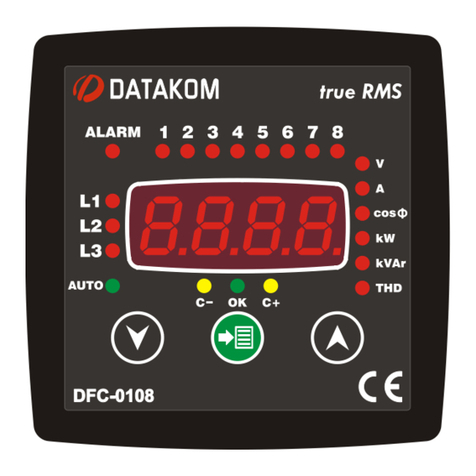
Datakom
Datakom DKG-108 User manual
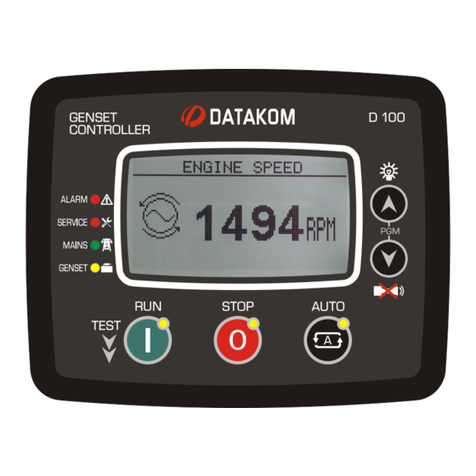
Datakom
Datakom D-100 MK2 User manual

Datakom
Datakom D-500 MK2 User manual
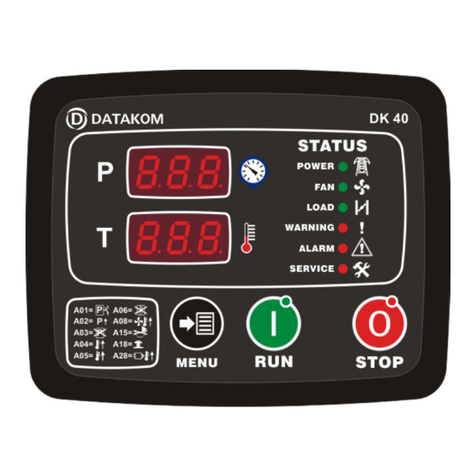
Datakom
Datakom DK-40 User manual
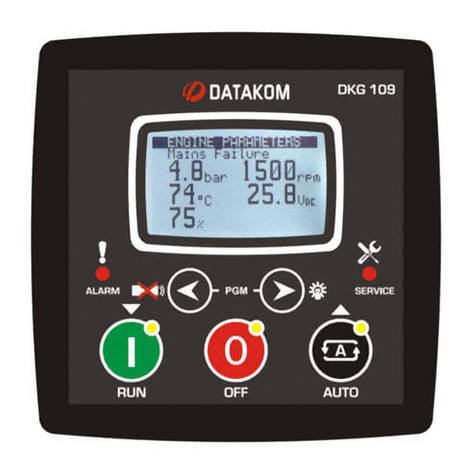
Datakom
Datakom DKG-109 User manual
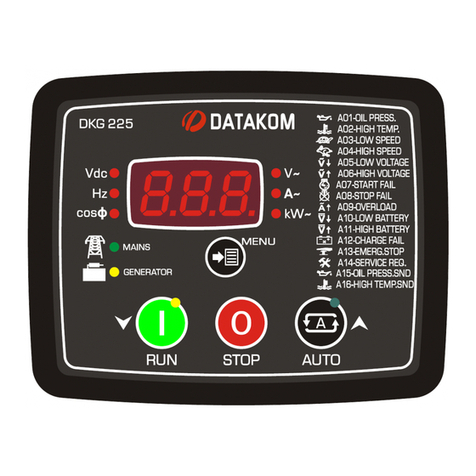
Datakom
Datakom DKG-225 User manual
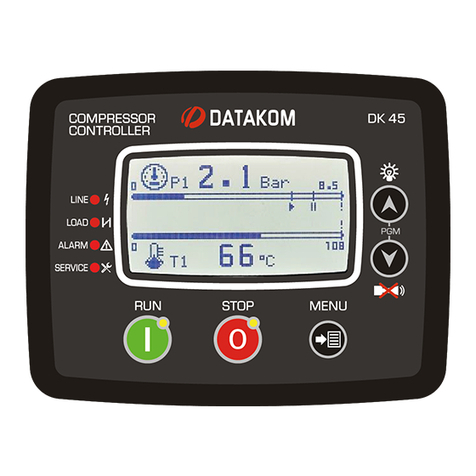
Datakom
Datakom DK-45 MK2 User manual
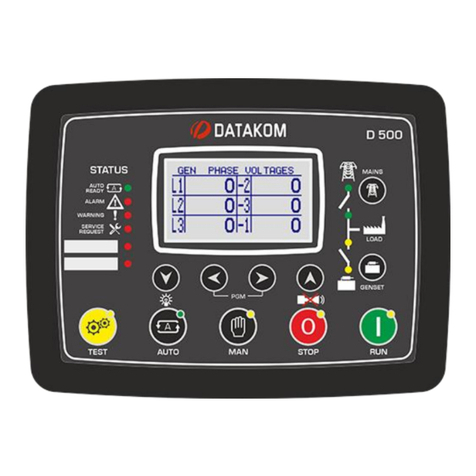
Datakom
Datakom D-500 MK3 User manual
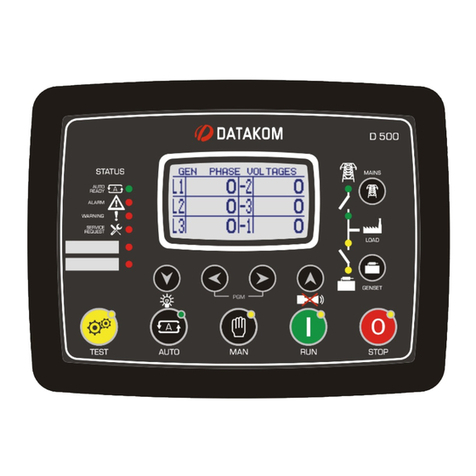
Datakom
Datakom D-500 User manual

Datakom
Datakom D Series User manual
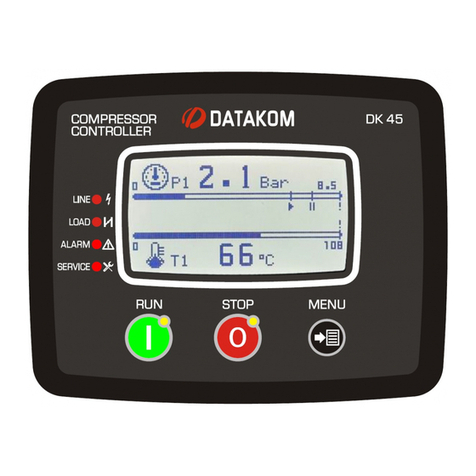
Datakom
Datakom DK-45 User manual
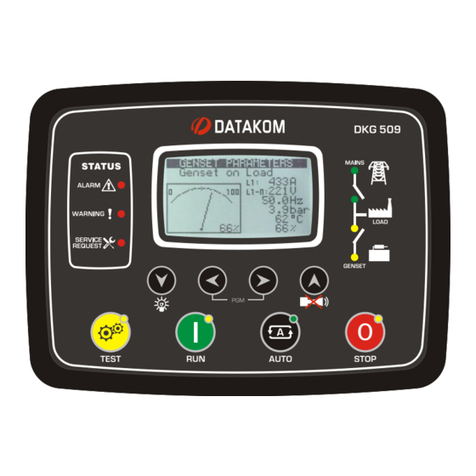
Datakom
Datakom DKG-509 User manual
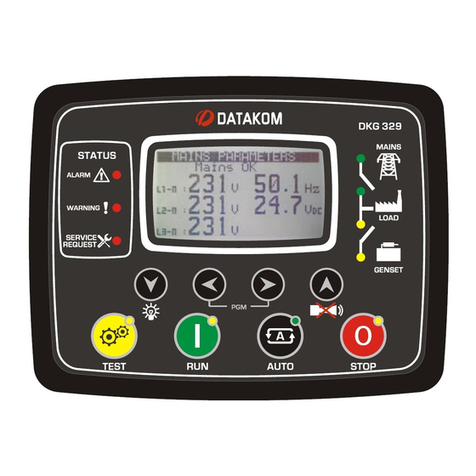
Datakom
Datakom DKG-329 User manual
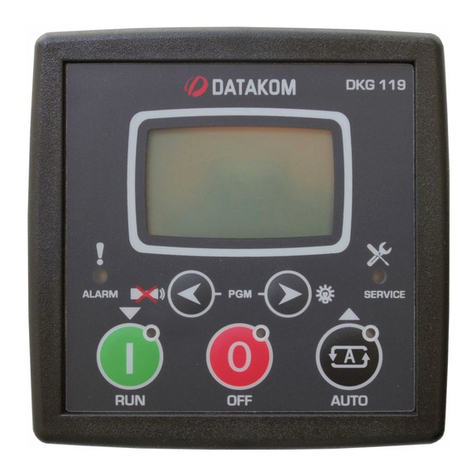
Datakom
Datakom DKG-119 User manual
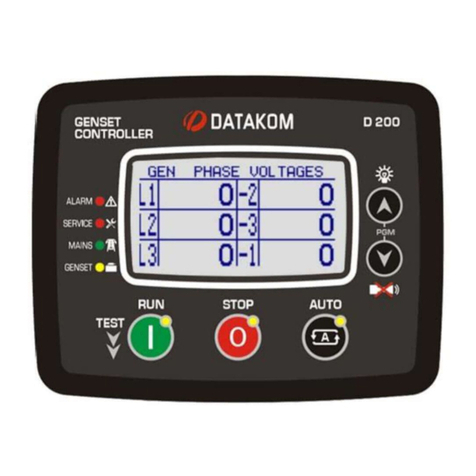
Datakom
Datakom D-200 MK2 User manual

Datakom
Datakom DKG-225 User manual
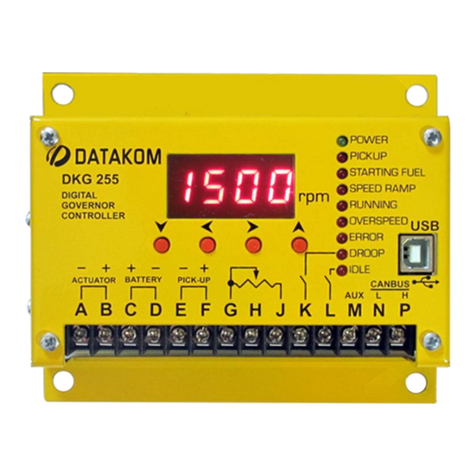
Datakom
Datakom DKG-255 User manual

Datakom
Datakom DKG-325 User manual

Datakom
Datakom D-700 MK3 User manual

Datakom
Datakom D-500 MK3 User manual
